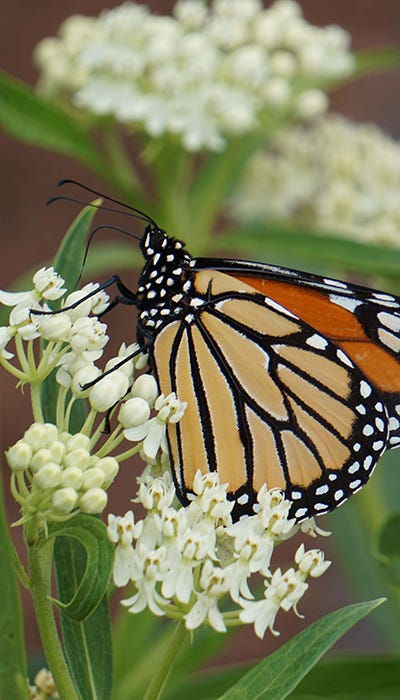Monarchs & Milkweeds

Monarch Butterflies: Beautiful Garden Visitors
The gorgeous American Monarch butterflies (Danaus plexippus), with their orange wings, black veining and a distinctive black and white checkered pattern around the margins, are instantly recognizable by gardeners and non-gardeners alike. As a defense against predators, Monarch butterflies contain unpalatable chemicals that can actually cause some birds to vomit! And their bold wing pattern is a well-known warning to hungry birds that they should not trifle with those Monarchs.
Milkweed Is Essential For Monarch Butterflies
By current estimates, the overall number of American Monarchs has fallen by 90% in the last decade. The decline of Monarchs is directly linked to the loss of milkweed plants in the wild. Milkweeds (all members of the genus Asclepias) are the host plants for Monarchs, meaning Milkweeds are the ONLY PLANT that Monarch larvae are able to eat, and the only plant where adult Monarch butterflies will lay their eggs.
What's contributing to the loss of milkweed plants across the country? Today, before beginning their spring planting, conventional farmers (those who do not use organic practices) will spray their fields with chemicals to eradicate weeds. Unfortunately, his practice also kills all the wildflowers, including the Milkweeds, that surround those fields. Also, as cities, towns, and neighborhoods expand, wild open meadows where native milkweed is typically found are disappearing.
The good news is that our gardens can make a difference!
The Amazing Monarch Migration
The amazing life cycle of the American Monarchs. If we are to reverse the appalling decline of these butterflies, it is helpful to understand more about of the remarkable life story of the American Monarch.
Eastern Monarchs
In the summertime, Eastern Monarchs can be found all the way from Mexico to southern Canada, and from the Rocky Mountains to the Eastern seaboard. All across this huge land area, four or sometimes five generations of Monarchs are born in a single season!
Starting in September and October, all Eastern Monarchs, (with the exception of a few that use the Atlantic seaboard) undertake a single prodigious migration to reach their over-wintering destination, the Monarch Butterfly Biosphere Reserve, in Southern Mexico.
During this migration, these tiny creatures fly the most astonishing distances. Those that begin their journey in the Canadian Maritime provinces will travel nearly five thousand miles to reach their winter destination in Central Mexico. Butterflies begin their fall migration in September or October, and finally reach their overwintering sanctuary in November.
The following March, those same butterflies set out on their northbound trip. However, no individual butterfly flies all the way north: At successive stops along the way, the female monarchs lay eggs on milkweed plants, and the resulting caterpillars initiate the new generation of butterflies that continue the journey northwards. It is estimated that in the course of the entire summer, eventually four or five generations will be raised.
In early fall, the final generation of females store their food supply in preparation for their long flight back to Mexico, instead of producing more eggs. These butterflies are also programmed to fly south or south-west depending on their starting points, to reach this single destination.
Western Monarchs
Like their eastern counterparts, the Western Monarch butterflies also have a migratory life cycle. Their summer territory is to the west of the Rocky Mountains, where typically, they will hatch three generations at successive points along those fly-ways.
Every fall, the third generation of these butterflies is programmed head south-west to reach one of several over-wintering destinations along the west coast of California and western Mexico.
Non-Migratory Monarchs
Unlike the Eastern and Western populations, American Monarch butterflies that are found in Florida and along the Gulf Coast do not migrate. This minor population remains in this warm climate on a year-round basis.
How Can Our Gardens Make A Difference? Plant Milkweed!
If we are to stop the decline of the Monarchs, and encourage their population to rebound, we need to ensure that milkweeds and other nectar producing flowers are available for the butterflies at each breeding point along their journey!
Milkweeds are the critical link for rebuilding our Monarch populations. The larvae of the butterflies absolutely require milkweed to survive - its the only food they can eat! Plant plenty of Milkweeds where Monarch butterflies can lay their eggs.
Adult butterflies love nectar-rich flowers to fuel their travels. Shasta Daisies, Blazing Star, Echinacea, Rudbeckia, Asters, ornamental Oregano, and Goldenrod are butterfly favorites in addition to Milkweed.
Today the Milkweeds are starting to make a come-back all across the country. Organic and regenerative practices in agriculture are growing, and the USDA is offering incentives for farmers and ranchers to plant milkweed and other pollinator friendly plants. Gardeners are also rallying to help the beleaguered butterflies! Since Milkweeds make great garden plants, many gardeners and schools are planting them, and people with larger properties are planting milkweeds as part of a naturalized meadow. For this effort to be truly effective, Milkweed restoration is required at each and every breeding point of these wonderful migratory butterflies. Every garden and Milkweed plant counts!

Add Milkweed Plants To Your Garden
Milkweed plants can be planted in spring or fall. Often, Milkweed can be slow to wake up from dormancy compared to other perennials in your garden. Follow our planting guide to learn more: How To Grow Milkweed
Grow Milkweed From Seed
Milkweed seeds require cold stratification. In most areas, when you plant seeds outside in the fall, seeds can go through the cold stratification process naturally. Learn more: How To Germinate & Grow Milkweed Seeds


